Explore Seoul - South Korea Travel, Asia
Seoul, officially known as Seoul Special City, is the capital and largest city of South Korea. It is located on the Han River in the northwestern part of the country and is the cultural, economic, and political center of South Korea. Seamlessly blending ancient traditions with cutting-edge innovation, though, Seoul has a rich history dating back to 18 BC when it was founded by the people of Baekje, one of the Three Kingdoms of Korea. This megacity buzzes with energy 24/7, its streets alive with the hum of commerce, the chatter of street markets, and the gentle chimes of palace bells. Travelers flock to Seoul for its intoxicating mix of ultramodern skyscrapers and serene Buddhist temples, world-class shopping districts and tranquil mountain trails.
Population: Approximately 10 million residents as of 2024
Economy: Seoul is South Korea's economic powerhouse, hosting key industries like technology, entertainment, and finance. The city is home to major corporations and a thriving startup ecosystem, significantly contributing to the national GDP. As a global tech hub and the heart of the Korean Wave, Seoul attracts millions of tourists annually, offering a dynamic mix of traditional and modern attractions. With an efficient transport system and a focus on sustainable tourism, Seoul is a prime destination for travelers looking to experience both rich history and cutting-edge innovation.
Landmarks: Gyeongbokgung Palace, N Seoul Tower, Deoksugung Palace, Changdeokgung Palace, Jongmyo Shrine, Bongeunsa Temple, Namsan, Cheongwadae (Blue House)
South Korea
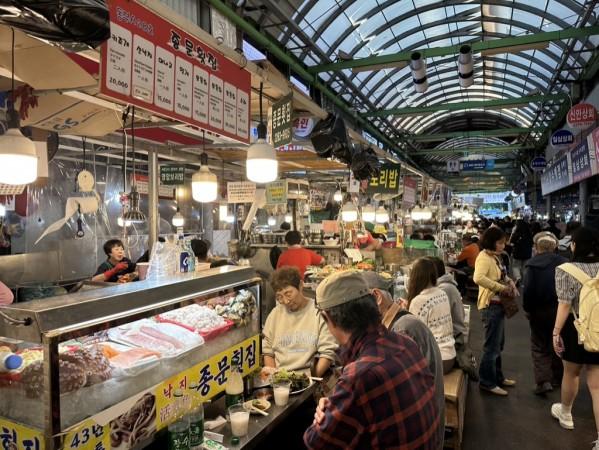
Overview of Seoul
History & Culture Influence
Seoul's origins date back to 18 B.C. when it was founded as the city of Wiryeseong by the Baekje Kingdom. Over the centuries, it became a vital political and cultural center, particularly during the Joseon Dynasty (1392-1910), which established Seoul as its capital. This era saw the construction of many iconic structures, including palaces, temples, and fortresses, that reflect the architectural styles and philosophies of the time. This strategic location between China and Japan made it a vital hub for trade and cultural exchange. The city's prominence grew during the Joseon Dynasty (1392-1910), which solidified Seoul's status as the capital of Korea. The dynasty was marked by significant advancements in arts, science, and governance, laying the foundation for modern Korean culture.
Interaction with The Locals
Interacting with locals in Seoul, visitors can expect a warm and welcoming atmosphere, shaped by the city’s rich cultural heritage and diverse population. Seoul is a bustling metropolis with a population of approximately 10 million, making it one of the largest cities in the world. The city is a melting pot of cultures, primarily consisting of ethnic Koreans, but it also hosts a growing number of expatriates and foreign residents from various backgrounds.

Bukchon Hanok Village - © gather
Top Attractions in Seoul
Seoul, the vibrant capital of South Korea, is home to top attractions such as Gyeongbokgung Palace, where visitors can experience the grandeur of Korean royal history, and N Seoul Tower, offering panoramic views of the city from its iconic observation deck. The bustling shopping district of Myeongdong and the traditional streets of Bukchon Hanok Village provide a perfect blend of modern and historic experiences for travelers.
Gyeongbokgung Palace
Location: 161 Sajik-ro, Jongno-gu, Seoul
Gyeongbokgung Palace, also known as the Northern Palace, is the largest of the Five Grand Palaces built by the Joseon dynasty. Constructed in 1395, it showcases stunning traditional Korean architecture and offers a glimpse into the grandeur of the Joseon era. Visitors can explore the palace grounds, including the iconic Gwanghwamun Gate, and witness the changing of the royal guard ceremony.
Namsan Park and N Seoul Tower
Location: 105 Namsangongwon-gil, Yongsan-gu, Seoul, South Korea
Namsan Park is a popular recreational area in the heart of Seoul, offering hiking trails and panoramic views of the city. At the top of Namsan Mountain stands the N Seoul Tower, a 236-meter-tall communication and observation tower. Visitors can ride a cable car to the tower's observation decks for breathtaking vistas or enjoy the park's natural beauty and hiking paths.
Bukchon Hanok Village
Location: 37, Gyedong-gil, Jongno-gu, Seoul
Bukchon Hanok Village is a well-preserved traditional residential area featuring hundreds of hanok houses dating back to the Joseon dynasty. Visitors can stroll through the charming alleyways, admire the unique architecture, and gain insights into the daily life of the past. Many hanok houses have been converted into cultural centers, tea houses, and boutique hotels, allowing visitors to immerse themselves in the traditional atmosphere.
Cheonggyecheon Stream
Location: Downtown Seoul, South Korea
Cheonggyecheon Stream is a 10.84-kilometer-long modern urban stream that runs through downtown Seoul. Restored from a covered overpass, the stream offers a peaceful respite from the bustling city. Visitors can enjoy a leisurely stroll along the stream, admiring the public art installations and bridges while surrounded by lush greenery.
Changdeokgung Palace and Huwon Secret Garden
Location: 99, Yulgok-ro, Jongno-gu, Seoul, South Korea
Changdeokgung Palace is a UNESCO World Heritage site and one of the Five Grand Palaces of the Joseon dynasty. The palace complex features stunning architecture and the Huwon Secret Garden, a well-preserved ecological garden that was once reserved for the royal family. Visitors can explore the palace grounds and join a guided tour of the secret garden to appreciate its natural beauty and historical significance.
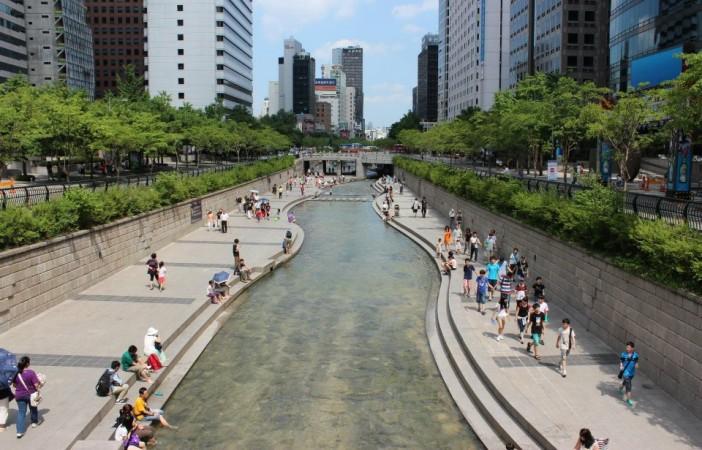
Cheonggyecheon, Seoul - © Grayswoodsurrey
Must-Try Dishes in Seoul
From flavorful mix of rice, vegetables, meat, fried egg to thick slices of grilled pork belly enjoyed with a variety of dipping sauces and side dishes. These are the street food that captures the essence of Seoul's vibrant culinary scene.
Bulgogi
Bulgogi is a classic Korean dish featuring thinly sliced, marinated beef that is grilled at the table. The meat is typically marinated in a sauce made from soy sauce, sugar, garlic, and sesame oil, which gives it a sweet and savory flavor. Bulgogi has been enjoyed since the Goguryeo era in the 37 BC–935 AD period, when it was considered a royal dish. Today, it remains one of the most popular Korean BBQ items and a staple of Seoul's cuisine.
Tteokbokki
Tteokbokki is a spicy, chewy rice cake dish that is a beloved Korean street food. Cylindrical rice cakes are simmered in a gochujang (chili pepper paste) sauce along with fish cakes, scallions, and boiled eggs. The dish originated as a royal court food in the 15th century but evolved into a popular snack in the 1950s. Tteokbokki can be found at street stalls throughout Seoul, especially in areas like Myeongdong and Namdaemun Market.
Kimchi
Kimchi is a staple side dish in Korean cuisine, made from fermented vegetables like napa cabbage or radish. It is seasoned with chili peppers, garlic, ginger, and salted seafood. Kimchi is known for its spicy, tangy, and umami flavors. It is considered a national dish of Korea and is served at nearly every meal. Seoul has a deep connection to kimchi - it is said that a meal without kimchi is almost incomplete. Visitors can learn about the art of kimchi-making at the Seoul Kimchi Academy.
Bibimbap
Bibimbap is a signature Korean dish consisting of warm white rice topped with sautéed and seasoned vegetables, gochujang (chili pepper paste), a fried egg, and often beef. The ingredients are meant to be mixed together thoroughly before eating. Bibimbap is known for its colorful presentation, with each ingredient symbolizing harmony and balance in Korean cuisine. It is a popular choice for its delicious flavors and versatility - vegetarian versions are also available. Bibimbap can be found at many Korean restaurants in Seoul.

Bulgogi - © Milk Street
Weather in Seoul: Best Time to Visit
Seoul experiences a continental climate characterized by four distinct seasons: cold, dry winters and hot, humid summers.
Average Temperatures
- Winter in Seoul: January is the coldest month with average temperatures around -2.1°C (28°F). Temperatures can drop as low as -6.2°C (21°F) at night.
- Spring in Seoul: March averages around 6.1°C (43°F), increasing to 18.3°C (64°F) in May. Spring is generally mild and pleasant.
- Summer in Seoul: July is the hottest month with an average temperature of 25.5°C (77.8°F), with highs reaching up to 35°C (95°F). August also remains warm, averaging around 26.3°C (79.3°F).
- Autumn in Seoul: September averages 21.6°C (71°F), dropping to 7.2°C (45°F) by November. October is particularly pleasant with mild temperatures.
Rainfall
- Annual Average: Seoul receives about 1,420 mm (55.9 inches) of precipitation annually.
- Wettest Months: July is the wettest month, averaging around 415 mm (16.3 inches) of rain. August also sees significant rainfall, averaging about 350 mm (13.8 inches).
- Driest Months: January is the driest month with approximately 15 mm (0.6 inches) of precipitation.
Best Time to Travel
- Spring (April to June): This is considered one of the best times to visit due to mild temperatures and blooming cherry blossoms.
- Autumn (September to November): Another ideal time for travel, featuring comfortable weather and beautiful fall foliage.
- Summer (July to August): While summer offers vibrant festivals, it is also hot and humid with heavy rainfall, which may not be suitable for all travelers.
- Winter (December to February): Cold temperatures and occasional snowfall can be appealing for those interested in winter sports or experiencing a traditional Korean winter.
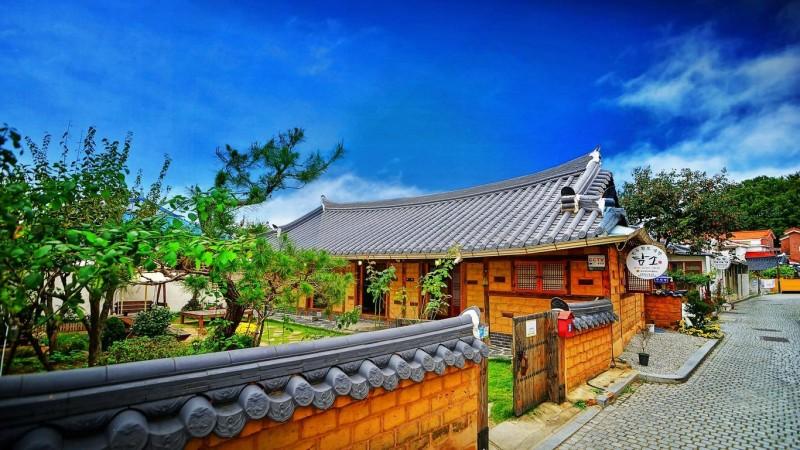
Jeonju Hanok Maeul Damso - © Momondo
Cultural Etiquette in Seoul
- Greetings and Introductions: In Korean culture, a slight bow is the customary greeting, with a deeper bow showing greater respect. When shaking hands, especially with elders or superiors, use both hands or your right hand supported by your left. Expect personal questions, as they reflect polite interest in your life.
- Dining Etiquette: Wait to be seated, allowing elders and those of higher status to sit first. The eldest are served first and begin eating before everyone else. Avoid pointing chopsticks at others, standing them upright in rice, or eating with your fingers. Pour drinks for others before serving yourself, using both hands.
- Gift Giving: Gifts are presented with both hands and received with a slight bow. Avoid giving white flowers, as they are associated with funerals.
- Manners and Customs: Remove your shoes when entering a home or some traditional restaurants. Avoid excessive body contact, as personal space is valued in Korean culture. Punctuality is highly respected, so strive to be on time. Modesty and humility are admired traits in Korean society.
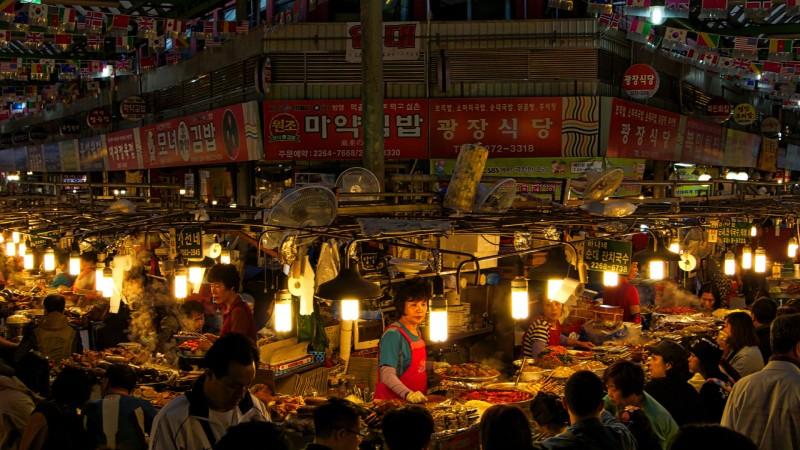
Gwangjang Market - © Chris and Sara
Essential Travel Information
Getting Around Seoul
- Subway System: Seoul's subway system is one of the most extensive and efficient in the world, featuring 9 main lines and several extensions. It operates from 5:30 AM to midnight and serves over 8 million passengers daily. The subway is known for its cleanliness, safety, and affordability, with fares starting at ₩1,250. Stations are equipped with multilingual signage, making it accessible for international travelers.
- Buses: The bus system in Seoul is also well-developed, with four types of buses categorized by color:
- Blue Buses: Connect suburban areas to the city center.
- Green Buses: Operate within districts, linking subway stations and neighborhoods.
- Red Buses: Express buses that connect the city center to the outskirts.
- Yellow Buses: Circulate within specific districts, ideal for tourists.
Buses are a cost-effective way to navigate the city, with fares typically starting at ₩1,200.
- Taxis: Seoul's taxis are plentiful and can be easily hailed on the street or booked via apps. Regular taxis are affordable, while deluxe taxis offer a more comfortable ride. The fare starts at ₩3,800, with additional charges based on distance and time. For convenience, it’s advisable to have your destination written in Korean.
ATM and Banking Services
- Availability: ATMs are widely available at airports, train stations, convenience stores, and bank branches.
- Languages: Most ATMs offer services in Korean and English.
- International Cards: Many ATMs accept international cards, but it's advisable to check for compatibility.
Where to Stay in Seoul
- Hotels: Seoul offers a wide range of hotels, from luxury international chains to budget-friendly options. Popular areas for tourists include Myeongdong, Gangnam, and Insadong.
- Guesthouses and Hostels: For budget travelers, guesthouses and hostels provide affordable accommodation with a social atmosphere. These are often located in central areas, making it easy to explore the city.
- Serviced Apartments: Serviced apartments are ideal for longer stays, offering more space and amenities like kitchens. They are available in various parts of the city, catering to both business travelers and families.
- Traditional Hanok Stays: For a unique experience, consider staying in a traditional hanok house. These accommodations offer a glimpse into Korean culture and history, with locations in areas like Bukchon Hanok Village.
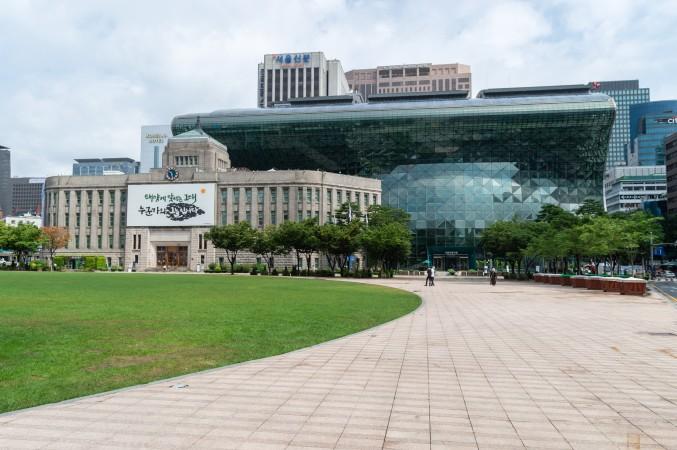
Seoul City Hall - © Tristan Surtel
Shopping in Seoul
Insadong
Insadong is known for its traditional Korean arts, crafts, and antiques. Wander through the narrow alleyways lined with galleries, craft shops, and teahouses. Some top spots include:
- Ssamziegil: A modern traditional craft mall with unique handmade crafts and souvenirs on each floor.
- Alive Museum: An interactive art museum with optical illusion exhibits great for photos.
- Jongno Antique Street: Browse antique shops and galleries selling Korean paintings, ceramics, and furniture.
Namdaemun Market
Namdaemun Market is Seoul's largest traditional market, selling everything from clothing and accessories to ginseng and souvenirs. Look for: Korean fans and traditional hats, Hanji (traditional Korean paper) products, Ginseng and Korean red ginseng candy
Dongdaemun Design Plaza (DDP)
The futuristic DDP complex houses design shops, galleries, and the Dongdaemun History & Culture Park. Check out:
- Designers' Village: Shops featuring up-and-coming Korean fashion and accessory designers.
- Dongdaemun Design Market: A 24-hour shopping complex with trendy Korean fashion and accessories.
Myeongdong
While known for its cosmetics shops, Myeongdong also has plenty of souvenir options like:
- Myeongdong Kyoja: Famous for kalguksu (knife-cut noodles) and mandu (dumplings).
- Myeongdong Alley Food Street: Stalls selling Korean street food like tteokbokki (spicy rice cakes).
- Myeongdong Cosmetic Shops: Pick up Korean beauty products as souvenirs.
Articles for you

Explore Yala National Park - Sri Lanka Travel, Asia
Tucked away in Sri Lanka’s southeastern corner, Yala National Park is where wild nature meets deep tradition. Known worldwide for its leopard population, the park is also home to elephants, sloth bears, crocodiles, and hundreds of bird species. Beyond wildlife, Yala opens doors to a cultural landscape dotted with ancient temples, Buddhist ruins, and coastal villages. For travelers seeking more than just a safari, Yala offers a chance to explore eco-tourism, local communities, and sacred heritage sites.
Population: The Yala National Park area doesn’t have a human population.
Economy: The economy around Yala National Park thrives on a blend of eco-tourism, agriculture, and local services. Safari tours, eco-lodges, and cultural experiences drive steady income for nearby towns like Tissamaharama and Kataragama, supporting thousands of families.
Landmarks: Famous for Block I of Yala and wildlife encounters, including elephants, sloth bears, crocodiles, and exotic bird species.

Explore Galle - Sri Lanka Travel, Asia
Nestled on Sri Lanka’s southern coastline, Galle is a vibrant city where history meets the sea. Its cobbled streets, colonial architecture, and serene beaches make it a must-visit destination for travelers seeking a blend of culture, adventure, and relaxation. A UNESCO World Heritage site, Galle captivates visitors with its Dutch Fort, bustling markets, and friendly locals. Whether you’re exploring the ramparts at sunset or savoring fresh seafood by the shore, Galle promises an unforgettable journey into Sri Lanka’s heritage.
Population: Approximately 113,000 in 2023.
Economy: Galle’s economy thrives on tourism, trade, and fisheries. The city’s historic fort, colonial architecture, and coastal charm draw thousands of international visitors each year, making tourism its main economic driver. Fishing remains vital for local livelihoods, supplying fresh seafood across the region.
Landmarks: Famous for the Galle Fort, Dutch Reformed Church & Maritime Museum, and Unawatuna Beach.

Explore Bentota - Sri Lanka Travel, Asia
Nestled along Sri Lanka’s southwestern coast, Bentota is a tropical paradise that blends golden beaches, vibrant culture, and thrilling adventures. Famous for its calm waters, luxury resorts, and scenic river estuary, Bentota has become a top destination for travelers seeking both relaxation and authentic experiences. From serene beach walks at sunrise to adrenaline-pumping water sports, this coastal town offers a perfect balance of leisure and exploration. With its proximity to Colombo and Galle, Bentota is easy to reach, making it an ideal stop for both short escapes and extended holidays.
Population: Approximately 37,000 in 2023.
Economy: Bentota’s economy thrives mainly on tourism, which drives local businesses such as hotels, restaurants, and wellness retreats. The town also benefits from fishing, coconut cultivation, and handicrafts like wood carving and batik textiles. Many residents rely on the growing demand for water sports and Ayurvedic treatments, making tourism the backbone of both income and employment in the area.
Landmarks: Famous for Bentota Beach, Bentota River Safari, and Kande Vihara Temple.

Explore Mirissa - Sri Lanka Travel, Asia
Mirissa is a charming coastal town on Sri Lanka’s southern shoreline. Known for its golden beaches, turquoise waters, and vibrant marine life, it has become a must-visit stop for travelers exploring the island. Many come for whale watching, surfing, and sunset views at Coconut Tree Hill, but Mirissa offers much more than postcard beauty. The fishing boats you see anchored by the bay carry generations of stories. Local traditions, delicious cuisine, and a laid-back rhythm of life shape every visitor’s experience.
Population: Approximately 4,700 in 2023.
Economy: Mirissa’s economy is largely shaped by its coastal location. Fishing has long been the backbone of local livelihoods, with generations relying on the Indian Ocean for income. In recent decades, tourism has become the main driver of growth, thanks to whale watching, surfing, and beachside hospitality.
Landmarks: Famous for Mirissa Beach, Coconut Tree Hill, and Parrot Rock Bridge.

Explore Nuwara Eliya - Sri Lanka Travel, Asia
Tucked away in the Central Highlands of Sri Lanka, Nuwara Eliya is often called “Little England”. With its rolling tea plantations, cool misty mornings, and colonial charm, this mountain town feels like a step into another world. Travelers come here to breathe fresh air, walk through flower gardens, sip the finest Ceylon Tea, and enjoy a pace of life far from the island’s busy cities. Whether you’re drawn by scenic landscapes, heritage architecture, or the warmth of its people, Nuwara Eliya is a destination that blends nature, culture, and history in perfect harmony.
Population: Approximately 781,000 in 2023.
Economy: Nuwara Eliya’s economy thrives mainly on tea production, as it sits in the heart of Sri Lanka’s central highlands, famous worldwide for Ceylon Tea. The city also benefits from a growing tourism industry, attracting visitors with its colonial charm, cool climate, and scenic landscapes.
Landmarks: Famous for Gregory Lake, Hakgala Botanical Garden, and Victoria Park.

Explore Sukau - Malaysia Travel, Asia
Nestled on the banks of the Kinabatangan River in Sabah, Malaysian Borneo, Sukau is a destination where wildlife, culture, and conservation come together. Known as one of Asia’s top spots for river safaris and eco-tourism, this quiet village offers a front-row seat to encounters with Bornean orangutans, pygmy elephants, proboscis monkeys, and exotic birdlife.
Population: Approximately 1,400 in 2019.
Economy: Sukau’s economy is shaped by its riverine location and natural resources. Traditionally, the Orang Sungai community relied on fishing, small-scale farming, and forest gathering for their livelihood. Today, the village has shifted toward eco-tourism, with river cruises, jungle trekking, and homestays providing income.
Landmarks: Famous for the Kinabatangan River cruises, Gomantong Caves, and Ox-bow lakes and wetlands.
